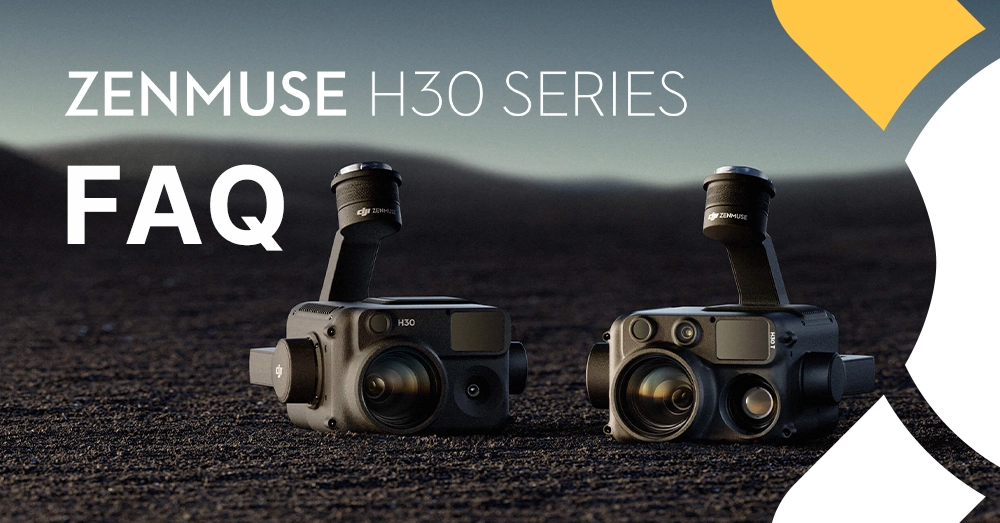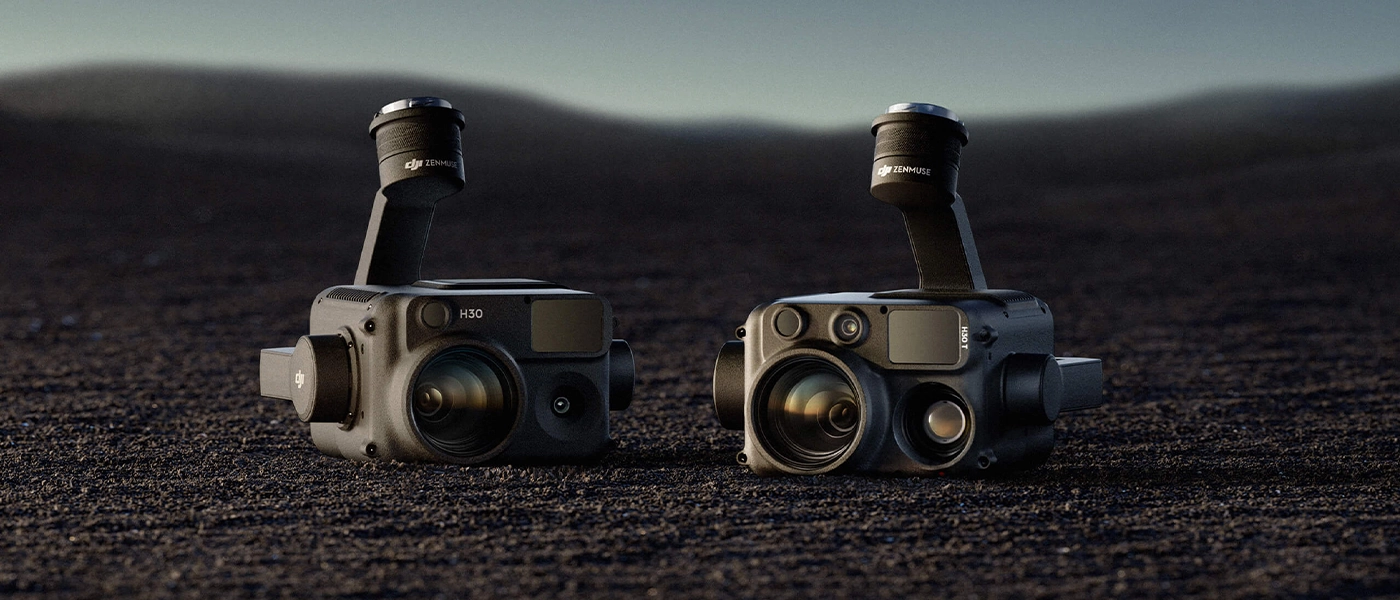DJI Zenmuse H30/H30T - FAQ


DJI Zenmuse H30/H30T Frequently Asked Questions
How many models are included in the Zenmuse H30 series?
The Zenmuse H30 series consists of 2 models:
Zenmuse H30 (four modules):
- wide angle camera
- zoom camera
- laser rangefinder
- nIR auxiliary light
Zenmuse H30T (five modules):
- wide angle camera
- zoom camera
- laser rangefinder
- infrared thermal imaging camera
- nIR auxiliary light
Which drone platforms are compatible with the Zenmuse H30 series?
Matrice 350 RTK and Matrice 300 RTK. The only compatible remote control is the DJI RC Plus. Before use, update the drone and remote control firmware to the latest version.
On which port of the gimbal can I mount a Zenmuse H30 series payload?
Any of the Zenmuse H30 series payloads can be mounted on any of the gimbal ports on the Matrice 350 RTK or Matrice 300 RTK.
What are the differences between Zenmuse H30 Series and H20 Series?
1. Enhanced visible-light capabilities: Supports up to 34× optical zoom and 400× digital zoom.
2. Improved infrared thermal imaging camera:
- resolution increased from 640×512 to 1280×1024;
- mode High-Res for better observation of objects with small temperature differences;
- extended temperature measurement range from -20° to 1600° C (-4° to 2912° F)*.
3. Enhanced night shooting capabilities, with adjustable frame rates of 25 fps, 15 fps and 5 fps; with additional nIR illumination.
4. Increased laser targeting range up to 3000 meters.
5. Support for Smart Capture.
6. Supports electronic dehazing.
7. Provides foreground stabilization for video, increasing the efficiency of operations such as power line inspections.
* With the infrared density filter installed, the maximum measurement temperature can reach 1600°C (2912°F).
What is the protection level of Zenmuse H30 series products?
Zenmuse H30 series cameras have the protection of the IP54.
Under controlled laboratory conditions, the Zenmuse H30 series can achieve IP54 protection according to IEC60529. IP rating is not permanent and may decrease over time due to product wear and tear.
What is the zoom ratio of the Zenmuse H30 series?
Ratio for Zenmuse H30 is 34× optical zoom and 400× digital zoom.
What are the image resolutions of Zenmuse H30 series cameras?
- Camera Zoom: 7328×5496, 3664×2748
- Wide-angle camera: 8064×6048, 4032×3024
- Infrared thermal imaging camera: 1280×1024
What video formats are supported by Zenmuse H30 Series?
The DJI Zenmuse H30 series supports such codecs as MP4, H.264 and H.265.
What is the difference between VBR and CBR in video bit rate settings?
VBR stands for Variable Bitrate, which offers a lower bitrate for static scenes and a higher bitrate for dynamic ones. This ensures optimal video quality in a variety of recording scenarios, but requires a microSD card capable of handling peak bit rates.
CBR stands for Constant Bitrate, where the bitrate remains constant regardless of the scene, and recording speeds on a microSD card are more consistent.
What is the new pre-recording feature in Zenmuse H30 series? What it's for?
Pre-recording is a feature that allows the device to buffer a video segment for a specified period of time before the user starts recording. Once recording begins, the buffered content is appended to the video, preventing excessive use of space on the microSD card.
Purpose: When the pre-recording function is enabled, even if recording begins after the event has started, the device can save moments before recording begins on the microSD card, ensuring that potentially critical information is not missed.
What is the maximum video recording time of Zenmuse H30 Series?
Two hours. Recording will automatically stop after two hours.
Is Zenmuse H30 Series compatible with DJI FlightHub 2 cloud platform?
Yes, the DJI zenmuse H30 is compatible with the platform DJI FlightHub 2.
What precautions to keep in mind when using Zenmuse H30 Series?
1. Do not point the camera lens at high-powered energy sources such as the sun, lava or laser beams. The temperature of the observed objects should not exceed 800°C (1472°F) (when IR density filter is not installed). Otherwise, it will burn out the infrared sensor and cause irreparable damage.
2. Do not place the product in direct sunlight, in areas with poor ventilation, or near a heat source such as a radiator.
3. Do not repeatedly turn the gimbal and camera on and off. After switching off, wait at least 30 seconds before switching on again. Otherwise, it may affect the life of the camera chips.
4. Do not replace the microSD card during use.
5. Do not touch the lens surface with your hand. Be careful not to scratch the surface of the lens with sharp objects. Otherwise, the quality of the photos may deteriorate.
6. Clean the surface of the camera lens with a soft, dry and clean cloth. Don't use alkaline detergents.
7. Store the cargo in a secure box, in a dry and ventilated place. The recommended ambient humidity is between 40% and 50%.
What are the application scenarios of Zenmuse H30 series?
These products are suitable for a wide range of applications, including but not limited to geothermal inspection, firefighting and search and rescue, forest fire prevention, wildlife protection, power line inspection, oil and gas inspection, traffic enforcement, facility inspection and infrastructure inspection.
Frequently asked questions for the Zenmuse H30T thermal imaging camera
What are the differences between the three gain modes of the Zenmuse H30T? What application scenarios do they correspond to?
- High Gain Mode offers more precise temperature measurement capabilities, with a measurement range of -20° to 150° C (-4° to 302° F).
- Low Gain Mode provides a wider temperature measurement range, from 0° to 600° C (32° to 1112° F).
- High-Res Mode is designed to observe objects with small temperature differences, making the object clearer. Temperature measurement is not supported in this mode.
How many ways can I measure temperature with Zenmuse H30T?
- Spot measurement: Touch any spot in the infrared thermal camera view to display the temperature of that spot.
- Measuring temperature at a central point: Tap on the center point in the infrared thermal camera view to display the temperature at that point for more precise measurements. Tapping outside the focal point exits the focal point temperature measurement mode.
- Area measurement: Tap to select any area in the infrared thermal camera view to view the highest and lowest temperatures in that area along with their locations.
What is the flat field calibration (FFC) of the Zenmuse H30T?
Flat-field calibration is used to optimize the quality of the thermal image, making it easier to observe temperature changes. You can manually enable the FFC by disabling automatic FFC adjustment in the settings.
Why uneven dark or light areas appear on the image after repeated manual FFCs?
Continuous manual FFC without a break is not recommended, as it may cause uneven heating of the infrared thermal camera shutter, resulting in inconsistent images. If this happens, perform FFC every 30 seconds and the image should return to normal.
What is the accuracy of the Zenmuse H30T temperature measurement?
In a windless laboratory environment at 25°C (77°F), observing a blackbody from a distance of 13 meters:
- Without the IR density filter installed, the measurement accuracy in high gain mode is ±2°C or ±2%, and in low gain mode is ±5°C or ±3% (whichever is greater).
- After installing the infrared density filter, the measurement accuracy for temperatures ≤ 1000° C (1832° F) is ±80° C (176° F) or ±8%; for temperatures > 1000° C (1832° F), it is ±100° C (212° F) or ±10% (whichever is greater).
What is the focus distance of the infrared thermal imaging camera on the Zenmuse H30T? Does the focus distance affect the accuracy of temperature measurements?
The minimum focusing distance is 13 meters. Within a radius of 13 meters, it does not affect the accuracy of temperature measurement, but the image will be blurry. It is recommended to keep a sharpening distance of more than 13 meters.
What software can be used to post-process thermal images taken by Zenmuse H30T?
The software that can be used to process thermal images is DTAT3 (DJI Thermal Analysis Tool 3) version 3.3.0 or later.
Whether the infrared resolution of 1280 × 1024 is based on the original sensor size or an algorithmic improvement?
This is the native size of the sensor with a resolution of 1280×1024.
What is the UHR (ultra-high resolution) infrared imaging feature of the Zenmuse H30T?
This feature allows you to capture clear images when the infrared thermal camera is set to a zoom of 5× or greater.
What factors can affect the temperature measurement accuracy of the Zenmuse H30T infrared thermal imaging camera?
Factors such as object emissivity, distance, ambient temperature and humidity can affect the accuracy of temperature measurements.
How to set infrared temperature measurement parameters for Zenmuse H30T?
Infrared temperature measurement parameters can be set in the dJI Pilot 2 application. The application allows automatic reading of laser rangefinder values and ambient temperature, as well as manual setting of object emissivity and ambient humidity values to correct temperature measurement results.
What is the main strategy of the Zenmuse H30T sensor burn protection function?
The H30T will automatically close the shutter when it detects conditions that could cause IR sensor burn-in. However, software detection may fail. Do not point the lens of the infrared thermal imaging camera toward high-energy sources such as the sun, lava or laser beams. Otherwise, it will burn the camera and cause irreparable damage.
What the infrared density filter on the Zenmuse H30T is used for?
Expands the temperature measurement range of the thermal imaging module to 0° to 1600° C (32° to 2912° F), enabling more efficient evaluation of temperature changes and quick location of high temperature points. When the IR density filter is installed, IR signal reception is reduced, which also degrades image quality. Not suitable for observing objects at normal temperature and is recommended to be used in low gain mode.
Zenmuse H30/H30T visible light camera - frequently asked questions
What is the Night Scene mode in Zenmuse H30 series?
Improves image quality in low-light conditions, presenting clearer and more accurate visual information to ensure efficiency and precision during nighttime operations.
How night scene mode has improved in H30T compared to H20N?
The H30T's night scene mode allows adjustment of 25 fps./s, 15 fps./s and 5 fps./s at a maximum sensitivity of ISO 819,200, offering improved noise reduction and support for NIR illumination.
Why in Night Scene mode, higher levels of noise reduction reduce the smoothness of live broadcasts?
Higher levels of noise reduction result in lower frame rates, longer exposure times and higher sensitivity, as well as better noise reduction performance. However, due to the reduced frame rate, the smoothness of the live video is reduced accordingly.
What is the electronic haze removal function of Zenmuse H30 series and how to select the intensity of haze removal?
Electronic haze removal is an image processing technique designed to reduce image blurring and haze effects caused by light scattering, atmospheric moisture and other factors. Uses computer algorithms to optimize and restore images, increasing clarity and quality. Electronic low-level haze removal is mainly designed for use in mild haze conditions, while electronic high-level haze removal works well in situations such as post-rainfall fog and moderate haze.
Can I enable electronic haze removal in Night Scene mode?
Not. Electronic haze removal is for use in daytime haze, while Night Scene mode is for use in low-light conditions at night. Both require image processing, but due to different application scenarios and purposes, their effects will conflict, so they are not supported simultaneously.
Why electronic haze removal is only supported by a zoom camera?
Varifocal cameras usually observe objects that are farther away and more susceptible to rain, fog and haze in the air. Therefore, electronic haze removal is primarily intended for a camera with a zoom lens.
What is the maximum zoom supported by the zoom camera when taking high-resolution grid photos?
Maximum zoom supported during grid shooting is up to 15× zoom.
What is smart capture mode and what are its main application scenarios?
Smart shooting mode allows you to automatically adjust camera parameters based on different scenes and lighting conditions to get higher quality photos. However, shooting speed may be slower compared to single-shot mode. Smart capture is suitable for all scenarios.
What is the measurement and mapping accuracy of Zenmuse H30 series?
The H30 series allows general surveying and mapping with an accuracy of ≤ 10 cm.*
* Measured under the following conditions in a DJI lab environment: Zenmuse H30 mounted on a Matrice 350 RTK and turned on. Using the DJI Pilot 2 area route to plan a flight path. RTK in FIX status. The relative altitude was set at 80 m, the flight speed was set at 10 m/s, the gimbal pitch was set at -90°, and each straight section of the flight path was less than 1500 m. The field contained objects with distinct angular features and used exposed control points on a hard ground that were consistent with the diffuse reflection model. After post-processing with DJI Terra, a horizontal accuracy of 10 cm was achieved.
What is the minimum focus distance of Zenmuse H30 series visible light cameras?
For a zoom camera, the minimum focus distance is 1.5 meters below the 5× zoom, 5 meters between the 5× and 20× zooms, and 10 meters above the 20× zoom. For a wide-angle camera, the minimum focus distance is 1 meter.
What is the infrared light function of the Zenmuse H30T and what are the scenarios of its use?
Switches the live image to a grayscale image by removing the infrared filter, thus enhancing the contrast between light and dark areas, making it easier to locate objects.
Infrared light is only supported when using a zoom camera.
NIR auxiliary light - frequently asked questions
What is the function of the additional NIR light in the DJI Zenmuse H30 series?
Additional NIR light provides additional NIR illumination in low-light conditions (less than 1 lux, crescent moon), improving covert night observation and search and rescue operations.
NIR auxiliary light is supported only when using a zoom camera and only after the drone is launched. If the NIR auxiliary light is turned on first, the infrared light will also turn on simultaneously.
What are the limitations of additional NIR light in DJI Zenmuse H30 series?
1. In low-light/dark conditions (e.g., urban areas at night), Night Scene mode will suffice. In such conditions, it is not recommended to turn on additional NIR light, as it may cause image whitening and reduce contrast.
2. When observing at distances of more than 200 meters in low-light/dark conditions or in weather conditions such as rain or fog, the backscattering of light due to the Tyndall effect by particles in the air can lead to image whitening and reduced contrast.â
Zenmuse H30/H30T laser rangefinder - Frequently Asked Questions
What is the measurement range of the DJI Zenmuse H30 series laser rangefinder? What is the blind zone?
The range is 3-3000 meters, with the upper limit of the measurement distance being 3000 meters, and the lower limit is 3 meters.
Range for common objects: meadows 2000 m, forests 1900 m, road surfaces 1700 m.*
Data measured in the DJI lab. Rangefinder data may vary depending on the material and shape of the object under test, as well as the effect of Cardan joint angle, ambient lighting and weather conditions such as rain or fog. If a laser pulse hits multiple targets, its energy is dissipated, which can reduce the measurable distance.
* Test conditions: Object with a flat surface, object size exceeding the diameter of the laser beam, atmospheric visibility of 23 km (smaller range in good weather compared to cloudy skies), laser falls at an oblique angle (with an incidence angle of approx. 0.2 radians) .
What are the challenging scenarios for the DJI Zenmuse H30 series laser rangefinder?
1. Weather conditions such as rain, fog, mist or snow.
2. Reflective objects and fully reflective objects.
3. Complex scenes with multiple themes.
What is the highest accuracy of the laser rangefinder in the DJI Zenmuse H30 series?
After maneuvering the drone forward, backward, left and right for about 10 seconds, the Zenmuse H30 series can achieve spot accuracy of 20 meters at a distance of 1 kilometer.


